

WikiLeaks’ Hits Pentagon Again With Leak Of 759 Guantanamo Prisoners’ Files - Andy Greenberg - The Firewall. 04-21 Interview with Terry Holdbrooks, former Guantanamo guard. This is our second interview in a series of interviews with former Guantanamo Bay detention camp guards and detainees.
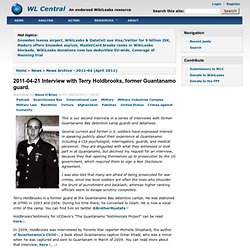
Several current and former U.S. soldiers have expressed interest in speaking publicly about their experience at Guantanamo: including a CIA psychologist, interrogators, guards, and medical personnel. They are disgusted with what they witnessed or took part in at Guantanamo, but declined my request for an interview, because they fear opening themselves up to prosecution by the US government, which required them to sign a Non Disclosure Agreement. I was also told that many are afraid of being prosecuted for war crimes, since low level soldiers are often the ones who shoulder the brunt of punishment and backlash; whereas higher ranking officials seem to escape scrutiny completely.
Terry Holdbrooks is a former guard at the Guantanamo Bay detention camps. He was stationed at GTMO in 2003 and 2004. Tell me a little bit about yourself before you entered the military. Secret US files on Mamdouh Habib and David Hicks released by WikiLeaks. The US military's Camp Delta prison at the Guantanamo Bay naval base in Cuba. Picture: AP Source: AP FORMER Guantanamo Bay detainee Mamdouh Habib told Egyptian interrogators under "extreme duress" he planned to hijack a Qantas plane and had prior knowledge of the September 11 attacks on the United States, according to newly-released WikiLeaks files. The documents also allege fellow Australian Guantanamo detainee David Hicks was approached to become a martyr by al-Qa'ida's number three in charge of military operations, but refused the invitation.
Mr Habib's Guantanamo prisoner file appears to confirm he was tortured by Egyptian authorities in 2001, making a raft of “admissions” which he later recanted. In its latest high-profile information release, WikiLeaks has begun releasing 779 secret files from the United States' notorious Guantanamo Bay prison camp. WikiLeaks: Guantanamo Bay terrorist secrets revealed. Only about 220 of the people detained are assessed by the Americans to be dangerous international terrorists.
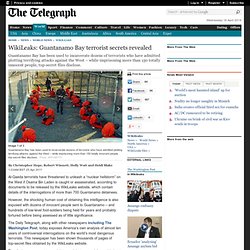
A further 380 people are lower-level foot-soldiers, either members of the Taliban or extremists who travelled to Afghanistan whose presence at the military facility is questionable. Who's still being held at Guantanamo - Sacramento Living - Sacramento Food and Wine, Home, Health. Camp de Guantánamo. Un article de Wikipédia, l'encyclopédie libre.

Il y avait, à l'automne 2001 , environ 750 détenus originaires d'une vingtaine de pays différents. De 2001 à 2004 , plus de 200 prisonniers ont été relâchés ; beaucoup ont été jugés dans leurs pays d'origine comme les six prisonniers de nationalité française ou ceux bénéficiant d'amnistie comme plusieurs centaines d'Afghans.
En avril 2006, 558 personnes étaient emprisonnées à Guantánamo[1], nombre qui était descendu à 275 en mai 2008[2] et à 192 en janvier 2010[3], un an après l'échéance fixée par un décret présidentiel du président Barack Obama ordonnant la fermeture du centre. Ce chiffre était descendu à 171 détenus fin février 2012 [4]. Au total, 779 personnes sont passées par cet établissement entre 2002 et décembre 2008 , dont cinq s'étaient suicidées fin 2008 [5]. Le 16 novembre 2008 , le président Barack Obama a confirmé son intention de fermer le camp. Camp Iguana (Guantanamo Bay) Recreation yard, Camp Iguana Camp Iguana showers and restroom Camp Iguana is a small compound in the detention camp complex on the US Naval base at Guantánamo Bay, Cuba.
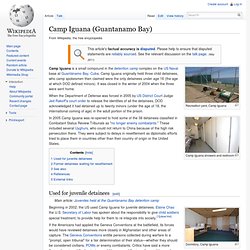
Camp Iguana originally held three child detainees, who camp spokesmen then claimed were the only detainees under age 16 (the age at which DOD defined minors). It was closed in the winter of 2004 when the three were sent home. When the Department of Defense was forced in 2005 by US District Court Judge Jed Rakoff's court order to release the identities of all the detainees, DOD acknowledged it had detained up to twenty minors (under the age of 18, the international coming of age) in the adult portion of the prison. In 2005 Camp Iguana was re-opened to hold some of the 38 detainees classified in Combatant Status Review Tribunals as "no longer enemy combatants.
" Waterboarding. Waterboarding is a form of torture, more specifically a type of water torture, in which water is poured over a cloth covering the face and breathing passages of an immobilized captive, causing the individual to experience the sensation of drowning.

Waterboarding can cause extreme pain, dry drowning, damage to lungs, brain damage from oxygen deprivation, other physical injuries including broken bones due to struggling against restraints, lasting psychological damage, and death.[1] Adverse physical consequences can manifest themselves months after the event, while psychological effects can last for years.[2] In the most common method of waterboarding, the captive's face is covered with cloth or some other thin material, and the subject is immobilized on his/her back.
Waterboard on display at the Tuol Sleng Genocide Museum: prisoners' feet were shackled to the bar on the right, wrists restrained by shackles on the left. Water was poured over the face using the watering can. Technique Dr. Torture Memos. For the Torture manuals, see U.S.
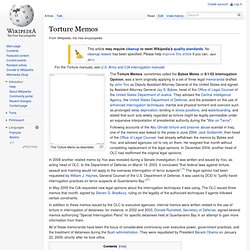
Army and CIA interrogation manuals The Torture Memo as described. The Torture Memos, sometimes called the Bybee Memo or 8/1/02 Interrogation Opinion, was a term originally applying to a set of three legal memoranda drafted by John Yoo as Deputy Assistant Attorney General of the United States and signed by Assistant Attorney General Jay S. Bybee, head of the Office of Legal Counsel of the United States Department of Justice. Amnesty International: waterboarding. John Walker Lindh. 'Platinum' captives held at off-limits Gitmo camp - Guantánamo Special Coverage.
GUANTANAMO BAY NAVY BASE, Cuba -- Call them the platinum prisoners.
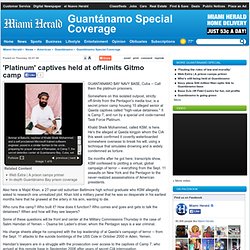
Somewhere on this isolated outpost, strictly off-limits from the Pentagon's media tour, is a secret prison camp housing 15 alleged senior al Qaeda captives called ''high-value detainees.'' It is Camp 7, and run by a special unit code-named Task Force Platinum. Khalid Sheik Mohammed, called KSM, is here. He's the alleged al Qaeda kingpin whom the CIA this week confirmed it covertly waterboarded somewhere overseas to break his will, using a technique that simulates drowning and is widely condemned as torture. Six months after he got here, transcripts show, KSM confessed to plotting a virtual, global campaign of terror -- everything from the Sept. 11 assaults on New York and the Pentagon to the never-realized assassinations of American presidents.
Also here is Majid Khan, a 27-year-old suburban Baltimore high school graduate who KSM allegedly asked to research one unrealized plot.